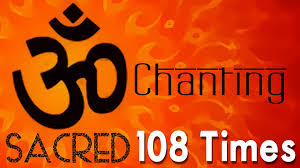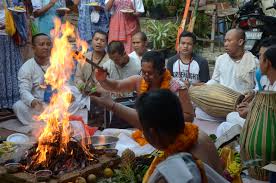During our childhood , most of us have been taught with few Sanskrit verses by our parents/grand parents and said they were Mantras. We were told that these mantras would help us study better, make us courageous and several other positive things. I am sure that at one point or other we all have pondered what is a mantra and benefits of mantra chanting? This article is for all those who wants to understand the significance of mantras and the science behind the mantra chanting.
What is a Mantra & Benefits of Mantra Chanting
The ancient Rishis realized that it is possible to awaken the cosmic forces within us through sound vibrations. Mantras are a combination of sounds used to connect to higher powers and manifest subtle cosmic powers of consciousness . Mantras are instruments, tools or medium by which one can explore and realize energy patterns and awaken the dormant centers of consciousness.

The word mantra corresponds to the power of vibration through which one can manage and free ones mind. Mantra is a Sanskrit word and can be split into two- “man” meaning mind and “tra” means projection. Mantra may be a word or set of words which when recited in a rhythmic manner transports our mind into a deeper level of consciousness. Mantra is defined as ‘mananaat ttraayate iti mantraha’, that is the power or force or energy through which one is able to liberate the mind from its obsessions. Hope till now you have understood what is a mantra and its importance. Let us now get little deeper to understand the science behind mantra chanting and benefits of mantra chanting.
The Science Behind Mantra Chanting
Mantra has both psychological and spiritual powers. It has the ability to transform the subconscious impulses and your behavioral patterns. You will be wondering how this is possible. To understand that it’s important to realize the power and science behind sounds. Science has proved that sound travels as waves and produces electromagnetic vibrations. This can impact our body as each body part or organ has its own frequency and vibration as mentioned below
- Each mantra awakens a particular area or centre of the mind and the brain.
- The Chakras (in the human body) is balanced with the power is the mantra.
- Mantras vibrations influence the body elements or tatwa- earth, water, fire, air and ether. For example – A mantra which influences water element will work on the mind or a mantra which influences the agni or fire element will work on prana or life force.
- Every mantra has a particular portfolio. It has an area of action and involvement which is predefined. For example, Gayatri Mantra is to enhance intelligence and awaken dormant talents. Mrityunjaya Mantra is chanted for the purpose of healing. The Durga mantras are to overcome difficulties in life.
Mantras are healing sounds that uplift our mood and helps us access heightened levels of awareness. It sets our mind as well as the atmosphere in the desired ambiance. In the system of mantra, one needs to identify with the vibration totally, for this reason the same mantras are to be repeated for For 15 to 20 minutes. When you are able to
- Sustain the mantra repetition with total awareness
- Identify yourself with the mantra vibration
- Feel the mantra vibrating internally
Then you begin to experience what is called mantra meditative awareness. where you are using the mantra to deepen your meditative awareness, and the effect will be total. One must understand that no mantra is less powerful or more powerful than the other. It is the quality of your practice and intention that you put into your saadhana that is more important and deeper you can go into that experience.
Types and Stages of Mantra Practice
The Yogic traditions have described three types of mantra practice, they are Baikhari, Upanshu and Manasa.
- Baikhari – The mantra will be chanted verbally and as loud as you wish, this is more suitable for beginners who have disturbed mind. The is the simplest and most effective method to make the mind peaceful.
- Upanshu – The Mantra here is chanted in whispering mode, the lips are moved but they do not create external sound. Only the practitioner himself can hear the mantra. This is done by people who chant mantras for long hours.
- Manasa – This is a mental chanting, there is no audible sound emitted, yet the mantra is clearly heard mentally. This is the most subtle of the three modes. The chanting should be done when the mind is very calm and free of thoughts repetition, which is the highest and the most difficult.

Universal mantras and Sakaama or desire oriented mantras can be chanted aloud. The mantras used for anushthan that is a fixed course of saadhana, and for araadhana that is for worship are to be chanted upanshu that is whispering sound. The Guru mantra and beeja or seed mantras are to be repeated mentally.
The Mantra Sadhana
The most common form of mantra chanting is verbal or baikhari. It is the primary class of mantra, where you become aware of the vibration, by the sound and the pitch that you are creating. After practicing verbal chanting for a certain period of time the tendency to internalize the awareness comes automatically. That is when you have to go to the next stage of practice which is Maansa, the mental practice. The best mantra sadhana is maanasa or mental, but the problem here is that during the practice, as the mind becomes focused, as it concentrates more and deeper, there is a tendency to sleep, by loosing awareness. Ultimately one has to go to the level of perfection in sadhana, where mantra repetition can happen with total mental attention without missing a single mantra or a single moment of awareness.

There are specific rules for Mantra Sadhana. Take a look below.
- Sit facing East or North with comfortable seating underneath.
- Select comfortable sitting posture or Asana (Siddha, Padma or Virasana)
- Sit with your back upright, and do not shake or move while chanting. Chanting should be done with a fixed posture to allow the complete effect of the sound energy.
- Use Spatika, Tulasi, Rudraksha Malas for counting the number of chants.
- Never sit for Mantra chanting with a full stomach. have fixed timing, better early in the morning in empty stomach. Take a bath before you start, if possible, or at least wash hands and feet.
- The duration of each tone is fixed and one should chant the mantra according to the swara with each syllable should be properly uttered with the required stress and pronounced with clarity.
Benefits of Mantra Chanting (General)
Now let’s summarize the overall benefits of mantra chanting. Chanting mantra has three fold benefit on persons Physical, Mental and Spiritual aspects. Listed below are the General benefits of mantra chanting. However there are more specific benefits on chanting few different types of mantra (Gayatri, Mritunjaya, Shiva, Ohm), which will be discussed in a different article.
Physical Benefits:
- By constant chanting and repetition of a mantra, the breathing gets regulated, it lowers heart beat, calms brain waves and relaxes the breath and the Prana naturally gets enhanced . As a result the body gets purified and unwanted toxins are removed.
- If you practice mantra chanting regularly, you will have good appetite, be cheerful always, handsome figure, good strength and zeal, a high standard of health, vigour and vitality and good concentration of mind.
Mental Benefits:
With consistent practice of mantra chanting you begin to get pure, divine thoughts, good positive energy flows into your Mind. Your Mind gets purified. When the Mind is purified, all the six enemies of the mind – desire, angry, greediness, ego, delusion and jealousy gets weakened and lose their grip over you.
Spiritual benefits:
By constant repetition of a Mantra, you can hold the attention continuously on the real Cosmic Vibration until the chanting changes from subconscious to the real super conscious chanting. This will bring the actual perception of God into the Divine Presence. With this you can develop renunciation, which leads to liberation, which leads to self-realization or to God.
Hope this article helped you in understanding what is a mantra chanting, mantra sadhana and benefits of mantra chanting, if you are looking for more information, feel free to post your comments in the comment section.
- Krishnashtakam – “Krishnam Vande Jagadgurum” – Lyrics & Meaning - April 4, 2024
- Karadarshanam – “Karagre Vasate Lakshmi” – Meaning & Benefits - March 26, 2024
- Spiritual Meaning of Smelling Smoke – Here Is What It Means? - March 20, 2024


0 Comments
Trackbacks/Pingbacks